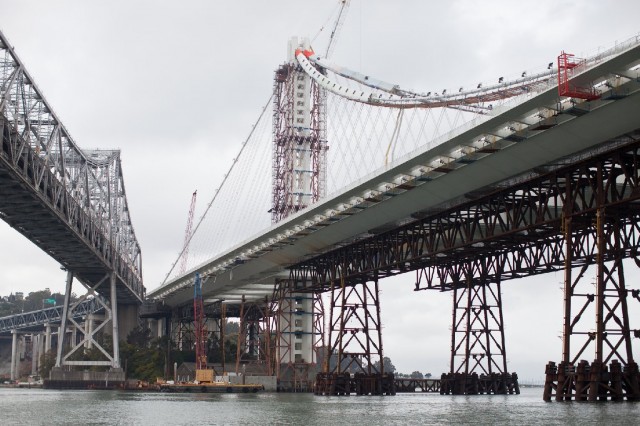"This was built into the bridge," Van Derbeken told KQED's Ted Goldberg. "They had a choice to either accept this -- and it was clearly in violation of Caltrans' own rules and the bridge welding code." Van Derbeken said independent engineers told him, "It's not a good idea to create these kinds of stresses on these welds."
Toll Bridge Program Oversight Committee spokesman Andrew Gordon said a seismic safety panel went over the misaligned plate problem in 2010 and determined the ill-fitting plates were acceptable.
"The bridge is safe. This issue of minor misalignment, at only 10 of those 26 connections, and of that, only about 7 percent of those connections, is not an issue for the structure, for seismic performance, or for the 150-year life span," he said.
Gordon cited a November 2010 report recently published on the oversight committee's website that found, due to compression from the bridge's "self-anchored" suspension design, that the larger welds were acceptable.
Van Derbeken talked to several engineering experts who disagree, however, including UC Berkeley professor emeritus in civil engineering Bob Bea, quoted below in the Chronicle:
To allow the welded connections, the lead contractor, American Bridge/Fluor Enterprises, needed Caltrans to exempt it from the agency's own standards and the American Welding Society's code for bridges. Both specify that the vertical gap between two pieces of steel on a bridge can be no more than an eighth of an inch.
Many of the Bay Bridge joints on the steel sections were off by as much as three times the acceptable level. But American Bridge/Fluor Enterprises was facing pressure to finish the long-delayed eastern span, as was Caltrans. In early 2011, the agency agreed to the nonstandard connections.
As a result of that decision, the bridge decks have several connections that have extra stress on them, which could lead to significant damage to the road deck in an earthquake, some experts said.
(Bob) Bea, the professor emeritus at Berkeley, likened an extended welded connection to a dent in an aluminum can.
"When you think of a beer can between two large hands, if you have a small dent in the beer can, it will collapse very easily," Bea said. "It's how we impress a lady in a bar - but it's no way to build a bridge."
Bea is among the experts expected to attend a technical workshop hosted by the oversight committee on Wednesday, Feb. 26, beginning at 1 p.m. The gathering will be held at 311 Burma Road in Oakland, and it will focus on another issue with the new bridge that's been a concern since last March.
Broken bolts
The Caltrans technical team will update the public about ongoing testing on the 2,600 bolts that are similar to 32 that snapped last year after they were tightened.
Those bolts were determined to be from a bad batch, weakened by "hydrogen embrittlement due to a lack of uniformity in the microstructure of the steel."
A permanent fix for those bolts -- a saddle system with steel cables -- was installed in December.
Bridge engineers have been soaking test bolts -- some from the bridge and some extras -- in salt water for days, then stressing them until the break. Gordon says they are all performing well above the level of stress they're under on the bridge.
"We are seeing very significant differences between all the other rods on the bridge that we've been testing and that initial batch that broke," he said.
How much difference is disputed. Recent tests found the bolts to be far stronger than the first round of testing did.
Water in the spine
Heavy rain this month exposed a separate issue -- leaks into the roadbed's steel spine. Some experts say it could lead to rust and weaken the bridge.
Gordon called the leaks an "anticipated issue," though engineers are still uncertain exactly why about 30 percent of bolts that connect the barrier rails to the suspension sections of the bridge are leaking.
The inside of the steel is zinc-primed, and Gordon said Caltrans is running de-humidifiers to remove excess moisture that could lead to rust. He said there have been no signs of corrosion on the actual structure, but that filings left over from construction are rusting.
"We want to remind everyone that the bridge is still under construction," Gordon said. "When the bridge opened last September, all structural and seismic work was completed. But there's still additional work going on ... so we're still buttoning up the bridge."
He said engineers will be following leaks during expected storms later this week.
